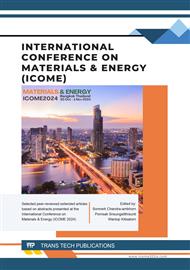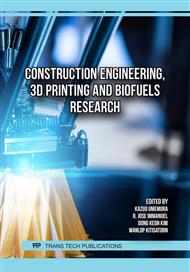[1]
Zhang, Y., He, C. Q., Tang, B. J., Wei, Y. M., China's energy consumption in the building sector: A life cycle approach, Energy and Buildings. 94 (2015) 240-251.
DOI: 10.1016/j.enbuild.2015.03.011
Google Scholar
[2]
Ma, Y. X., Yu, C., Impact of meteorological factors on high-rise office building energy consumption in Hong Kong: From a spatiotemporal perspective, Energy and Buildings. 228(2020) 110468.
DOI: 10.1016/j.enbuild.2020.110468
Google Scholar
[3]
Yang, L., Ya n, H., Lam, J. C., Thermal comfort and building energy consumption implications–a review. Applied energy. 115 (2014) 164-173.
DOI: 10.1016/j.apenergy.2013.10.062
Google Scholar
[4]
Bayoumi, M., Energy saving method for improving thermal comfort and air quality in warm humid climates using isothermal high velocity ventilation, Renewable energy. 114 (2017) 502-512.
DOI: 10.1016/j.renene.2017.07.056
Google Scholar
[5]
Moon, H. J., Ryu, S. H., Kim, J. T., The effect of moisture transportation on energy efficiency and IAQ in residential buildings, Energy and Buildings. 75 (2014) 439-446.
DOI: 10.1016/j.enbuild.2014.02.039
Google Scholar
[6]
Rahim, M., Douzane, O., Le, A. T., Langlet, T. Effect of moisture and temperature on thermal properties of three bio-based materials, Construction and Building Materials. 111 (2016) 19-127.
DOI: 10.1016/j.conbuildmat.2016.02.061
Google Scholar
[7]
Rahim, M., Douzane, O., Le, A. T., Promis, G., Laidoudi, B., Crigny, A., Langlet, T., Characterization of flax lime and hemp lime concretes: Hygric properties and moisture buffer capacity, Energy and Buildings. 88 (2015) 91-99.
DOI: 10.1016/j.enbuild.2014.11.043
Google Scholar
[8]
Boutin, M. P., Flamin, C., Quinton, S., & Gosse, G., Analyse du cycle de vie: Compounds thermoplastiques chargés fibres de chanvre et Mur en béton de chanvre banché sur ossature bois. Rapport d'Étude INRA Lille, Réf. MAP, 4, B1(2005).
Google Scholar
[9]
Maalouf, C., Le, A. T., Umurigirwa, S. B., Lachi, M., & Douzane, O., Study of hygrothermal behaviour of a hemp concrete building envelope under summer conditions in France, Energy and buildings. 77 (2014) 48-57.
DOI: 10.1016/j.enbuild.2014.03.040
Google Scholar
[10]
El Ganaoui, M., Hristov, J., Analytical and innovative solutions for heat transfer problems involving phase change and interfaces. Comptes rendus. Mécanique, 340(7) (2012).
Google Scholar
[11]
Memon, S. A., Phase change materials integrated in building walls: A state of the art review, Renewable and sustainable energy reviews, 31 (2014) 870-906.
DOI: 10.1016/j.rser.2013.12.042
Google Scholar
[12]
Yang, Y., Shen, Z., Wu, W., Zhang, H., Ren, Y., & Yang, Q., Preparation of a novel diatomite-based PCM gypsum board for temperature-humidity control of buildings. Building and Environment, 226 (2022) 109732.
DOI: 10.1016/j.buildenv.2022.109732
Google Scholar
[13]
Mendes, N., Philippi, P. C., Lamberts, R., A new mathematical method to solve highly coupled equations of heat and mass transfer in porous media, International Journal of Heat and Mass Transfer. 45(3) (2002) 509-518.
DOI: 10.1016/s0017-9310(01)00172-7
Google Scholar
[14]
Wijesuriya, S., Tabares-Velasco, P. C., Biswas, K., Heim, D., Empirical validation and comparison of PCM modeling algorithms commonly used in building energy and hygrothermal software, Building and Environment. 173 (2020) 106750.
DOI: 10.1016/j.buildenv.2020.106750
Google Scholar
[15]
L.P. Li, Z.G. Wu, Y.L. He, G. Lauriat, W.Q. Tao, Optimization of the configuration of 290×140×90 hollow clay bricks with 3-D numerical simulation by finite volume method, Energy and Buildings 40(10) (2008) 1790-1798.
DOI: 10.1016/j.enbuild.2008.03.010
Google Scholar
[16]
N. Chennouf, B. Agoudjil, A. Boudenne, K. Benzarti, F. Bouras, Hygrothermal characterization of a new bio-based construction material: Concrete reinforced with date palm fibers, Construction and Building Materials 192 (2018) 348-356.
DOI: 10.1016/j.conbuildmat.2018.10.089
Google Scholar
[17]
W.C. Swinbank, Long-wave radiation from clear skies, Quarterly Journal of the Royal Meteorological Society 89(381) (1963) 339-348.
DOI: 10.1002/qj.49708938105
Google Scholar
[18]
Wu, D., Rahim, M., El Ganaoui, M., Bennacer, R., Liu, B., Multilayer assembly of phase change material and bio-based concrete: A passive envelope to improve the energy and hygrothermal performance of buildings, Energy Conversion and Management. 257 (2022) 115454.
DOI: 10.1016/j.enconman.2022.115454
Google Scholar



